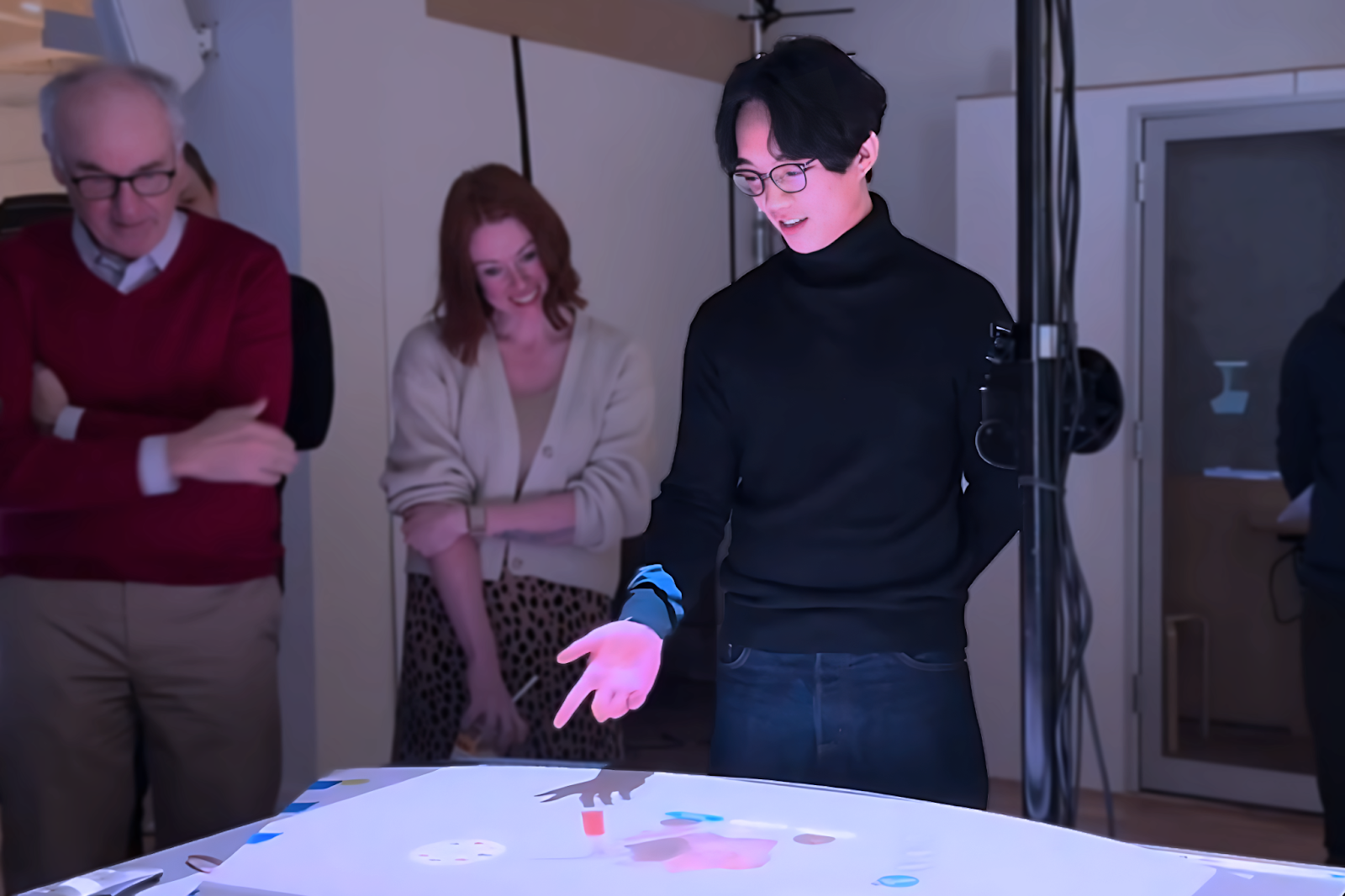
At the Cleveland Museum of Natural History, a boy leans over an illuminated table. He swipes his hand, and suddenly a prehistoric creature flickers into view, its story unfolding across the surface. His parents glance over as he lingers for a moment, then dashes off to the next gallery. The stop is brief, but it leaves him buzzing with curiosity.
Moments like this aren’t random. They come from months of planning, testing, and refinement by designers like Wang, who bridges architecture and user experience. In his hands, museums become more than repositories for objects; they become places where space and story intersect, and where visitors help advance the narrative.
From Architect to Experience Designer
Wang trained as an architect, but he didn’t stop at walls and plans. Architecture taught him how space quietly shapes behavior. At Steven Holl Architects, working on the Cofco Cultural and Health Center in Shanghai, he extended the tread depth of a library stair so it could double as seating. A circulation path became a place to read. At the CIFI Headquarters in Beijing, a curved wall and skylight formed a natural guide, directing people through the building without the need for signs. Those projects demonstrated to him that architecture can choreograph movement and set the tone of an experience.
Before joining G&A Strategy and Design, Wang began exploring how architecture could extend beyond static form into interaction and narrative. For the 2020 International Forum for Architecture Thesis Design in Taiwan & Southeast Asia, he led both the exhibition and website design, creating a physical space that embodied the theme of resilience and guided visitors through light, structure, and rhythm by applying the honeycomb cardboard material to express both fragility and strength, mirroring the theme of resilience
His installation, The Island of Rain, which won the Good Idea Award at the Taipei New Horizon Creative Festival (2021), turned social interaction into a collective act. Visitors balanced on seesaws with friends or strangers to generate water vapor — a poetic reflection on post-COVID reconnection among human beings and Mother Nature.
Wang also designed the introductory film for Time-Travel through Taipei National Palace by Bar Hopping, an award-winning entry for the Taipei National Palace Museum’s Online Curator Competition (2020). The project features the storytelling of drinking culture in ancient China, showcasing artifacts from thousands of years through an online scrollytelling website.
These independent projects became the bridge between architecture and experience design — laboratories where Wang began to see how people, space, and story could move together.
His transition into museums took shape when he joined G&A Strategy and Design, a firm known for blending storytelling with spatial and digital experience. There, UX added a new layer: interaction. At the St. Nicholas Shrine in New York, he designed the multimodal donation kiosk and website, where clarity and hierarchy were crucial. Visitors needed to read, decide, and give without second-guessing. In contrast, motion-based interactives aim less at instruction and more at emotion. At the Cleveland Museum of Natural History, Stardust invites visitors to use their bodies to create a star and witness its life cycle in two minutes — a moment meant to spark wonder and lead them toward deeper content nearby. The Biodiversity Table leans toward education, letting visitors explore stories of six Ohio species and see how citizen scientists collect data through tools, observations, and animated graphics.
Across these experiences—transactional, emotional, and educational—the through line is clear: interaction shapes how people feel, act, and make sense of the world. Whether it’s the calm focus of giving, the jolt of discovery, or the depth of learning, Wang designs moments that engage both the senses and the mind.
Designing for Different Rhythms
Museums may look alike from the street, but inside their rhythms are set by mission and audience. Each one asks for a different pace: play, reflection, reverence.
At the Cleveland Museum of Natural History, the rhythm is exploratory and hands-on. The Mechanic of Evolution combines a physical crank with a touchscreen, allowing visitors to see how cartoony creatures evolve, mutate, and go extinct. The simple act of turning the crank becomes a doorway into more complex scientific ideas. Families often gather around it, children drawn first by the motion and parents staying to explain the underlying concepts.
At the Junior Achievement Dream Accelerator in Colorado, the tone is youthful and aspirational. Picture Your Strength asks teenagers to identify their traits, take a selfie, and decorate a profile with icons. It feels familiar, fast, and social, yet it nudges them toward a bigger thought: creativity and entrepreneurship often start with knowing your strengths.
At the Navy SEAL Museum in San Diego, the mood is quiet and reverent. The Featured Missions are anchored on the second floor. Through a restrained digital interface, visitors explore the honored stories of SEALs over time. Conversations become hushed, and people move at a slower pace. Here, design steps back so the story can lead.
Across these settings—educational, personal, and emotional—the process remains consistent, but the tone shifts to align with the mission. “It’s like using the same instrument,” Wang says. “The timbre may be familiar, but each place has its unique melody.”
The Composer Role
“I think of myself as a composer who sets the structure,” Wang says. “Each discipline is a performer, and the goal is to make the piece feel whole.” Architects think in volumes, developers in code, curators in narrative. His job is to bring those parts together into a single flow that the visitor can sense without needing to name it.
The roots date back to his time at Steven Holl Architects, where he worked on complex cultural projects in Shanghai and Beijing. There he learned to treat architecture as a living system—light, structure, circulation working together. Coordination isn’t just technical; it’s creative. Every choice changes how people move, feel, and respond. That mindset now anchors his museum practice at G&A Strategy and Design, where architecture, story, and media must perform in unity.
However, even the best composition evolves when new voices join in. At G&A Strategy and Design, the process works like an ensemble. “Everyone has an instrument,” he says, “and we play off one another to create excellent experiences.”
Collaboration and Process
At G&A Strategy and Design, collaboration isn’t a handoff; it’s the way ideas are made. Exhibit designers think spatially about how people move. Visual designers shape tone and mood. Motion designers explore how stories unfold in time. UX designers keep objectives and interaction at the center. Rather than working in sequence, teams co-create from the start. In brainstorming workshops, someone sketches approach and flow, another imagines pacing and motion, and another maps the interactive path. The overlap is intentional; it’s how the work stays coherent.
Collaboration also involves visitors. During user testing, designers present works-in-progress to participants who represent the target audience. They not only observe reactions but also invite suggestions. “There are no right or wrong answers,” Wang tells participants. “We want your honest feedback on what works, what doesn’t, and what could be improved.” For Wang and his team, feedback is not seen as a final judgment; instead, it becomes an integral part of the design process. A single comment can inspire a change that influences the next iteration.
This approach traces back to Wang’s graduate thesis on prototyping as a shared language. Instead of treating design as a closed loop, he framed it as a dialogue between makers and users. That philosophy still guides his work: collaboration across disciplines, institutions, and increasingly across the line between designer and visitor.
Looking ahead, he sees this widening collaboration as a path for museums. “What if visitors could leave behind a thought, an idea, a voice that becomes part of the exhibit and grows?” he asks. “That’s when a museum stops being static and starts growing with its audience.”
The Tough Parts
Museum design presents its own unique challenges. Time is the first. Most visitors spend less than three minutes on an interactive experience. That means complex ideas must land quickly and stick. For Wang, the measure isn’t how long someone stays, but whether a short encounter leaves a trace of curiosity or insight.
Production is another constraint. Budgets are fixed. Schedules are tight. Fabrication is complex. “A good idea has to survive reality,” he says. “It needs to work with the technology, the materials, and the ways people actually behave to solve the challenges creatively.”
Client collaboration also poses difficulties. Museums involve curators, educators, artists, donors, and visitors, each with distinct goals. Aligning them takes patience and translation. “My job isn’t to push one vision,” Wang says. “It’s to help each group see where their goals connect to the larger story.”
The Road Ahead
Museums are shifting from places of observation to places of participation, and the kinds of interactions Wang designs mirror this shift—from simple transactions to shared emotions to collaborative learning. Visitors don’t only want to look at history; they want to step into it.
His projects at G&A Strategy and Design point to that change. From Cleveland to San Diego, from entrepreneurship labs to sacred spaces, they demonstrate how story and space can create experiences that transcend screens or walls. Some invite action—tapping, spinning, waving. Others invite feeling—wonder, empathy, pride. Others build understanding—showing how personal stories connect to broader systems and histories.
The result isn’t a single style of exhibition, but a living ecosystem where each interaction, whether playful or solemn, contributes to meaning.
“In the end,” Wang says, “Action, emotion, learning—each has a place. Together, they shape how visitors find meaning.”
And he offers one more question: “If AI becomes part of museum experiences, will automation help bridge designers, curators, and visitors into a more seamless journey, or will it flatten the rough, diverse voices that give museums their power?”







